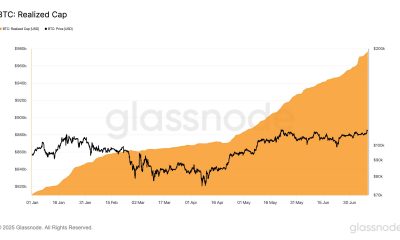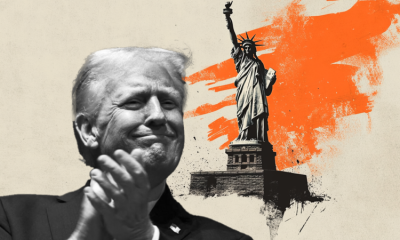

others
US Dollar extends losses after US CPI, Fed decision looms – Crypto News
- The DXY Index is trading with losses below the 104.00 mark.
- US November showed no surprises and confirmed a deceleration.
- Investors await Fed Interest Rate Decision due this Wednesday.
The US Dollar (USD) is currently undergoing a slight retreat as the DXY index trades at 103.85 after the release of November’s Consumer Price Index (CPI) figures from the US, which fueled dovish bets on the Federal Reserve.
Against a backdrop of cooling inflation and despite a strong labor market, the Fed appears susceptible to veering toward a more dovish stance. In that sense, Fed officials are not ruling out further policy tightening, so markets will closely monitor the bank’s stance at the upcoming meeting on Wednesday.
Daily Market Movers: US dollar dips after CPI data, markets see rate cuts in May 2024
- The US Dollar trades lower as investors assess the impact of US CPI data and dovish expectations from the Federal Reserve.
- In November, the US saw a predicted easing in inflation, according to the CPI. The CPI recorded a modest rise of 0.1% for the month. Compared to October’s 3.2%, the annual inflation rate slightly decreased to 3.1%.
- Core CPI reported by the US Bureau of Labor Statistics remained unchanged at 4% YoY, matching both the previous and expected figures.
- Meanwhile, US bond yields are down with 2-year, 5-year and 10-year yields at 4.71%, 4.23%, and 4.22%, respectively.
- According to the CME FedWatch Tool, a rate hike is not expected in Wednesday’s meeting, with the market betting on rate cuts likely to happen in May 2024.
Technical Analysis: DXY bulls hold resilient, indicators still weak
The indicators on the daily chart reflect a bit of a mixed picture for the pair. The Relative Strength Index (RSI) is in negative territory with a negative slope, indicating diminishing buying momentum. This is reaffirmed by the status of the Moving Average Convergence Divergence (MACD) indicator, which is registering decreasing green bars.
Bucking short-term cues, the Simple Moving Averages (SMAs) showcase a broader bullish trend. The pair remains above the 20-day SMA and crucially above the 200-day SMA, highlighting that bulls have the upper hand in a wider time frame despite temporary bearish leanings.
However, the pair’s position below the 100-day SMA suggests a note of caution and potentially a near-term consolidation or pullback phase. The ongoing action on the charts can be seen as bears taking a breather, while bulls remain resilient.
Support levels: 103.70 (20-day SMA), 103.50, 103.30.
Resistance levels: 104.50 (100-day SMA), 104.50, 104.70.
Fed FAQs
Monetary policy in the US is shaped by the Federal Reserve (Fed). The Fed has two mandates: to achieve price stability and foster full employment. Its primary tool to achieve these goals is by adjusting interest rates.
When prices are rising too quickly and inflation is above the Fed’s 2% target, it raises interest rates, increasing borrowing costs throughout the economy. This results in a stronger US Dollar (USD) as it makes the US a more attractive place for international investors to park their money.
When inflation falls below 2% or the Unemployment Rate is too high, the Fed may lower interest rates to encourage borrowing, which weighs on the Greenback.
The Federal Reserve (Fed) holds eight policy meetings a year, where the Federal Open Market Committee (FOMC) assesses economic conditions and makes monetary policy decisions.
The FOMC is attended by twelve Fed officials – the seven members of the Board of Governors, the president of the Federal Reserve Bank of New York, and four of the remaining eleven regional Reserve Bank presidents, who serve one-year terms on a rotating basis.
In extreme situations, the Federal Reserve may resort to a policy named Quantitative Easing (QE). QE is the process by which the Fed substantially increases the flow of credit in a stuck financial system.
It is a non-standard policy measure used during crises or when inflation is extremely low. It was the Fed’s weapon of choice during the Great Financial Crisis in 2008. It involves the Fed printing more Dollars and using them to buy high grade bonds from financial institutions. QE usually weakens the US Dollar.
Quantitative tightening (QT) is the reverse process of QE, whereby the Federal Reserve stops buying bonds from financial institutions and does not reinvest the principal from the bonds it holds maturing, to purchase new bonds. It is usually positive for the value of the US Dollar.
-
![DIS Elliott Wave technical analysis [Video]](https://dripp.zone/news/wp-content/uploads/2025/06/DIS-Elliott-Wave-technical-analysis-Video-Crypto-News-400x240.jpg)
![DIS Elliott Wave technical analysis [Video]](https://dripp.zone/news/wp-content/uploads/2025/06/DIS-Elliott-Wave-technical-analysis-Video-Crypto-News-80x80.jpg) others1 week ago
others1 week agoSkies are clearing for Delta as stock soars 13% on earnings beat – Crypto News
-
![DIS Elliott Wave technical analysis [Video]](https://dripp.zone/news/wp-content/uploads/2025/06/DIS-Elliott-Wave-technical-analysis-Video-Crypto-News-400x240.jpg)
![DIS Elliott Wave technical analysis [Video]](https://dripp.zone/news/wp-content/uploads/2025/06/DIS-Elliott-Wave-technical-analysis-Video-Crypto-News-80x80.jpg) others1 week ago
others1 week agoSkies are clearing for Delta as stock soars 13% on earnings beat – Crypto News
-

 Cryptocurrency6 days ago
Cryptocurrency6 days agoWhale Sells $407K TRUMP, Loses $1.37M in Exit – Crypto News
-
Technology1 week ago
XRP Eyes $3 Breakout Amid Rising BlackRock ETF Speculation – Crypto News
-
Technology1 week ago
Breaking: SharpLink Purchases 10,000 ETH from Ethereum Foundation, SBET Stock Up 7% – Crypto News
-

 Blockchain1 week ago
Blockchain1 week agoBitcoin Hits All-Time High as Crypto Legislation Votes Near – Crypto News
-
Business1 week ago
PENGU Rallies Over 20% Amid Coinbase’s Pudgy Penguins PFP Frenzy – Crypto News
-

 Blockchain7 days ago
Blockchain7 days agoRobinhood Dealing With Fallout of Tokenized Equities Offering – Crypto News
-

 Cryptocurrency6 days ago
Cryptocurrency6 days agoSatoshi-Era Bitcoin Whale Moves Another $2.42 Billion, What’s Happening? – Crypto News
-

 Metaverse1 week ago
Metaverse1 week agoHow Brands Can Deepen Customer Connections in the Metaverse – Crypto News
-

 Technology1 week ago
Technology1 week agoPerplexity launches Comet, an AI-powered browser to challenge Google Chrome; OpenAI expected to enter the space soon – Crypto News
-

 Cryptocurrency1 week ago
Cryptocurrency1 week agoBitcoin Breaks New Record at $111K, What’s Fueling the $120K Price Target? – Crypto News
-

 others1 week ago
others1 week agoEUR/GBP climbs as weak UK data fuels BoE rate cut speculation – Crypto News
-

 Blockchain1 week ago
Blockchain1 week agoSUI Chart Pattern Confirmation Sets $3.89 Price Target – Crypto News
-
Business1 week ago
US Senate To Release CLARITY Act Draft Next Week – Crypto News
-

 others1 week ago
others1 week ago$687,220,000 in Bitcoin Shorts Liquidated in Just One Hour As BTC Explodes To $116,000 – Crypto News
-

 Business1 week ago
Business1 week agoS&P Global Downgrades Saks Global’s Credit Rating – Crypto News
-

 others1 week ago
others1 week agoAnthony Scaramucci Says $180,000 Bitcoin Price Explosion Possible As BTC ‘Supremacy’ Creeps Up – Here’s His Timeline – Crypto News
-

 Cryptocurrency1 week ago
Cryptocurrency1 week agoBitcoin Breaks New Record at $111K, What’s Fueling the $120K Price Target? – Crypto News
-
Technology4 days ago
Fed Rate Cut Odds Surge As Powell’s Future Hangs In The Balance – Crypto News
-

 De-fi1 week ago
De-fi1 week agoOusted Movement Labs Co-Founder Sues Startup in Delaware Court – Crypto News
-
Business1 week ago
XRP Set for Big Week as ProShares ETF Launches July 18 – Crypto News
-
Technology4 days ago
Fed Rate Cut Odds Surge As Powell’s Future Hangs In The Balance – Crypto News
-
Business1 week ago
Breaking: US SEC Delays Grayscale Avalanche ETF Launch – Crypto News
-

 Technology1 week ago
Technology1 week agoOne Tech Tip: Click-to-cancel is over, but there are other ways to unsubscribe – Crypto News
-

 Technology1 week ago
Technology1 week agoGoogle DeepMind hires Windsurf CEO as OpenAI’s $3 billion acquisition collapses – Crypto News
-
Technology1 week ago
Hyperliquid Hits Record $10.6B OI As HYPE Price Records New ATH – Crypto News
-

 Blockchain1 week ago
Blockchain1 week agoZiglu Faces $2.7M Shortfall as Crypto Fintech Enters Special Administration – Crypto News
-
Cryptocurrency7 days ago
Why Is Bitcoin Up Today? – Crypto News
-

 Cryptocurrency6 days ago
Cryptocurrency6 days agoStrategy Resumes Bitcoin Buys, Boosting Holdings to Over $72 Billion in BTC – Crypto News
-

 Cryptocurrency6 days ago
Cryptocurrency6 days agoBitcoin Breaches $120K, Institutional FOMO Takes and House Debate Propel Gains – Crypto News
-

 Blockchain4 days ago
Blockchain4 days agoRipple and Ctrl Alt Team to Support Real Estate Tokenization – Crypto News
-
others1 week ago
Breaking: Robinhood Ethereum and Solana Staking Goes Live for US Customers – Crypto News
-
Technology1 week ago
HBAR Price Hits 1-Month High, Targets 150% Rally As Hedera Network Activity Soars – Crypto News
-

 Blockchain1 week ago
Blockchain1 week agoCoinbase Partners With Perplexity AI to Integrate Market Data – Crypto News
-

 Technology1 week ago
Technology1 week agoOutlook outage: Microsoft responds, but frustrated users clap back with hilarious memes – Crypto News
-

 Blockchain1 week ago
Blockchain1 week agoBitcoin Breakout Not Just Hype—$4.4B Inflows Back The Move – Crypto News
-

 Technology1 week ago
Technology1 week agoNvidia now briefly hits $4 trillion in trading, stocks and bitcoin rally – Crypto News
-
Technology1 week ago
ETH Is Next BTC? BlackRock Is Ditching Bitcoin And Buying More Ethereum – Crypto News
-

 others1 week ago
others1 week agoGold struggles to capitalize on its modest intraday gains amid mixed cues – Crypto News
-

 Blockchain1 week ago
Blockchain1 week agoXRP Price Builds Momentum — $2.50 Break Sparks Fresh Bullish Wave – Crypto News
-
![Cardano [ADA] price prediction - 8% rally next, but here's why you should be careful!](https://dripp.zone/news/wp-content/uploads/2025/07/Cardano-ADA-price-prediction-8-rally-next-but-heres.webp-400x240.webp)
![Cardano [ADA] price prediction - 8% rally next, but here's why you should be careful!](https://dripp.zone/news/wp-content/uploads/2025/07/Cardano-ADA-price-prediction-8-rally-next-but-heres.webp-80x80.webp) Cryptocurrency1 week ago
Cryptocurrency1 week agoCardano [ADA] price prediction – 8% rally next, but here’s why you should be careful! – Crypto News
-

 others1 week ago
others1 week agoBitcoin Primed for the Next Major Parabolic Advance, Says Crypto Analyst Kevin Svenson – Here Are His Targets – Crypto News
-

 others1 week ago
others1 week agoMultiBank Group Confirms MBG Token TGE Set for July 22, 2025 – Crypto News
-

 Cryptocurrency1 week ago
Cryptocurrency1 week agoWhy is ZK proof altcoin Lagrange (LA) dropping amid a rally in crypto market – Crypto News
-

 Blockchain1 week ago
Blockchain1 week agoSUI Explodes Higher, Climbing Above 20-Day MA — But Can The Rally Hold? – Crypto News
-

 Cryptocurrency1 week ago
Cryptocurrency1 week agoXRP price targets breakout above $3 as BTC hits fresh ATH – Crypto News
-
Technology1 week ago
Breaking: Jerome Powell Allegedly Considering Resignation Amid Trump’s Criticism – Crypto News
-
Business1 week ago
XRP Price Prediction As Bitcoin Makes News All Time Highs- Is XRP Next? – Crypto News
-

 others1 week ago
others1 week agoTop US-Based Crypto Exchange by Trading Volume Coinbase Adds Support for DeFi Tokens SKY and USDS – Crypto News












